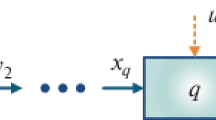Abstract
An algorithmic-evolutionary synthesis procedure is studied for generating the maximum energy recovery (MER) and minimum number of units (MNU) networks with the goal of achieving the global optimum network under pinch points. For pinched problems, sufficient conditions are proposed for determining the minimum number of units. These sufficient conditions, together with heuristic matching rules, are used to generate an initial feasible composite MNU/MER network. A split-merge network structure is introduced in order not to violate the prescribed minimum approach temperature. This initial network is successively evolved to obtain improved networks by limited heat load redistribution resulting from the pinch point. The properties and limitations of the constructions and procedures are established and the effectiveness of the heuristic procedure is illustrated with literature test problems.
Similar content being viewed by others
Abbreviations
- AP:
-
sub-problem above the pinch point
- BP:
-
sub-problem below the pinch point
- c:
-
heat capacity flow rate [kW/°C]
- C:
-
cooling requirement [kW]
- H:
-
heating requirement [kW]
- HC:
-
heat content of stream [kW]
- N:
-
number of streams
- n:
-
number of streams
- Q:
-
amount of heat exchanged [kW]
- S:
-
steam
- T:
-
temperature [°C]
- T*:
-
pinch temperature [°C]
- W:
-
cooling water
- x:
-
split ratio [kW/°C]
- ΔTm :
-
minimum allowable temperature approach [°C]
- AP:
-
sub-problem above the pinch point
- c:
-
cold stream
- h:
-
hot stream
- HE:
-
heat exchanger
- i:
-
inlet condition
- sp:
-
split stream
- t:
-
target condition
References
Lee, I. and Reklaitis, G. V.:Chem. Eng. Commun.,75, 57 (1989).
Linnhoff, B. and Hindmarsh, E.:Chem. Eng. Sci.,38, 745 (1983).
Grimes, L. E., Rychener, M. D. and Westerberg, A.W.:Chem. Eng. Commun.,14, 339 (1982).
Linnhoff, B., Mason, D. R. and Wardle, I.:Comput. Chem. Eng,3, 295 (1979).
Papoulias, S.A. and Grossmann, I.E.:Comput. Chem. Eng,7, 707 (1983).
Su, J. and Motard, R. L.:Comput. Chem. Eng,8, 67 (1984).
Wood, R. M., Wilcox, R.J. and Grossmann, I.E.:Chem. Eng. Commun.,39, 371 (1985).
Hohmann, E. C: Ph.D. Thesis, University of Southern California (1971).
Floudas, C. A. and Grossmann, I. E.:Comput. Chem. Eng.,10, 153 (1986).
Douglas, J. M.: “Conceptual Design of Chemical Processes”, McGraw-Hill, New York, NY (1988).
Jones, S.A. and Rippin, D.W. T.: Symposium Series No. 92, 157, PSE 85, Cambridge, England (1985).
Author information
Authors and Affiliations
Rights and permissions
About this article
Cite this article
Lee, IB. Synthesis of heat exchanger networks with minimum number of units for pinched problems. Korean J. Chem. Eng. 9, 117–127 (1992). https://doi.org/10.1007/BF02705128
Received:
Accepted:
Issue Date:
DOI: https://doi.org/10.1007/BF02705128




